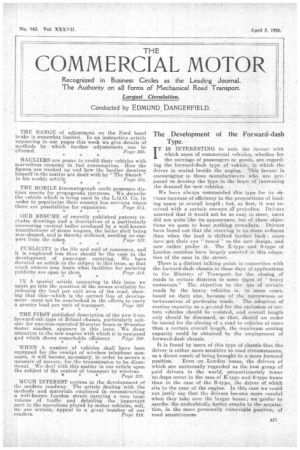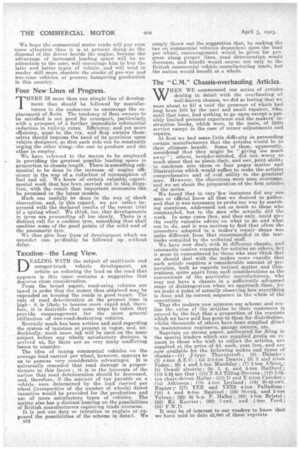The Development of the Forward - dash Type. '
Page 1

Page 2

If you've noticed an error in this article please click here to report it so we can fix it.
IT IS INTERESTINGto note the favour with which users of commercial vehicles, whether for the carriage of passengers or goods, are regard.; ing the forward-dash type of vehicle, in which the driver is seated beside the engine., This favour is encouraging to those manufacturers who are prepared to develop the type in the hope of. increasing the demand for -new vehicles. .
1,47.e have always commended this type for its obvious increase of efficiency in the proportions of loading space to overall length; but, at first, it was received with a certain amount 01 prejudice. Drivers asserted that it would not be so easy to steer, users did not quitelike its appearance, but of these objections we seem to hear nothing nowadays. Drivers have found out that the Eteering is no more arduous than when the load is shifted farther back ; users have got their eye " tuned " to the new design, and now .rather prefer it.. The K-type and S-type of London omnibus have largely assisted in this education of the man in the street..
There is a distinct talking point in connection with the forward-dash chassis,in these days of applications to the Ministry of Transport for • the closing . of roads in certain districts to some Vries of " heavy motorcars." The objection to the use of certain roads by the heavy • vehicles is. in some eases, based on their size, because of the narrowness or tortuousness of particular roads. The adoption of seating capacity as a ground for the exclusion of certain vehicles should be resisted, and overall length only should be discussed, so that, should an order he issued for the closing of a road to vehicles of more than a certain overall length, the maximum seating capacity could be obtained by the employment of forward-dash chassis. . .
It is found by users of this type of chassis that the driver is rather more sensitive to road circumstances, as a direct result of being brought to a more forward position. Even on London buses, the drivers of which are universally regarded as the hest group of paid drivers in the world, proportionately fewer niiiihaps occur in the ease of K-type and S-type buses than in the case of the B-type, the driver of whieh sits to the rear of the engine. In this ease we could not justly say that the drivers becOnie more careful when they take over the larger buses; we prefer to . ascribe the undoubtedly better results to the acquisi tion, .. tion, in the more personally vulnerable position, of road sensitiveness. We hope the commercial motor trade will pay even more attention than it is at present doing to the disposal of the driver beside the engine, because the advantage of increased loading space will be an attraction to the user, will encourage him to buy the later and better types of vehicle, and will tend to render still more obsolete the stocks of pre-war and war-time vehicles at present hampering production in this country.
Four New Lines of Progress. THERE IS more than one simple line of development that should be followed by manufacturers in the endeavour to encourage the replacement of fleets. The tendency of fleet. owners to be satisfied is not good for transport, particularly with a prospect of a further immediate substantial reduction in railway rates. Efficiency, and yet more efficiency, must be the cry, and fleq, owners themselves should impress the need of its prevision upon vehicle designers, so that each side can be constantly urging the other along—the one to produce and the other, to employ.
We have referred to the means to be employed • in providing the greatest possible loading space in proportion to chassis length. There is something substantial to be done in the increase of engine efficiency in the way of a reduction of consumption of fuel and oil. We know of certain valuable experimental work that has been carried out in this direction, with the result that important economies can be promised in the latest models.
Much can usefully be done in the way of shock absorption, and, in this regard, we are rather irepressed with the declared results of the recent trial of a spring wheel. We think, too, that developments in tyres are proceeding all too slowly. There is a distinct call for a cushion tyre something that shall combine some of the good points of the solid and of the pneumatic tyre.
We thus give four lines of development which we consider can profitably be followed up without delay.
Taxation—the Long View.
DEALING WITH the subject of multi-axle and creeper-track vehicle development, an article on reducing the load on the road that appears in this issue contains a suggestion that
deserves close consideration. .
From the broad aspect, road-using vehicles are taxed in order that the money thus.obtained may be expended on keeping the roads in good repair. The rate of road deterioration at the present time is high : it is likely to become more rapid and, therefore, it is desirable that some steps be taken that provide encouragement for the more general utilization of non-road-destroying vehicles.
Recently much has been written and said regarding the system of taxation at present in vogue, and, undoubtedly, much more ink will be used on the same subject before any wholly satisfactory decision is arrived at, for there are so very many conflicting issues to consider.
The idea of taxing commercial vehicles on the average load carried per wheel, however, appears to us to possess very considerable advantages. It is universally conceded that road damage is proportionate to this factor ; it is in the interests of the nation that road deterioration should be decreased, and, therefore, if the amount of tax payable on a vehicle were determined by the load carried per wheel (irrespective of the number of wheels) direct incentive would be provided for the production and use of more satisfactory types of vehicles. The matter also has a distinct bearing on the possibilities of British manufacturers capturing trade overseas. It is not our duty or intention to explain or expound the possibilities of the scheme in detail. We B18 simply throw out the suggestion that, by making the tax on commercial vehicles dependent upon the load per wheel, encouragement would be given for progress along proper lines, road deterioration would -decrease, and benefit would accrue not only to the British commercial vehicle manufacturing trade, but the nation would benefit at a whole.
The " C.M." Chassis-overhauling Articles.
WHEN WE commenced our series of articles dealing in detail with the overhauling of well-known chassis, we did so feeling that. we were about to fill a void the presence of which had long been felt by the user and small repairer, who, until that time, had nothing to go upon except a possibly limited personal experience and the makers' instruction books, which were, in the main, of little service except in the case of minor adjustments and repairs. At first we had some little difficulty in persuading certain manufacturers that the articles would be to their ultimate benefit. Some of them, apparently, considered that they might be " Fiving too much away " • others, broader-minded, aid not worry so much about that as about their, and our, joint ability to condense into three or four pages matter and illustrations which would suffice to make the articles comprehensive and of real utility to the practical man. However, the objections were soon overcome, and we set about the preparation of the first articles of the series.
We found that in verylew instances did any one man or official blow all that we desired to gather, and that it was necessary to probe our way by searching questions, addressed not so much to those who commanded, but to the men who actually did the work. In some cases they, and they only, could give the really valuable advice on what to do and what not to do, arid it was carious to find that. often the procedure adopted in a maker's repair shops was quite different from that recommended in the textbooks compiled by the technical staff. We have now dealt with 24 different chassis, and constantly receive requests for articles on others, but it must be remembered by those who may think that we should deal with the makes more rapidly that each article requires a considerable amount of preparation, both as regards textual matter and illustrations, quite apart from such considerations as the convenience of the particular manufacturers, who may not have a chassis in a sufficiently advanced stage of disintegration when we approach them, for we make a point of actually observing how everything is done and its correct sequence in the whole of the operations. , That the makers now approve our scheme and realize the value of the articles to their customers is proved by the fact that a proportion of the reprints which we have sold has gone to them for distribution, whilst thousands of others have been supplied direct to maintenance engineers, garage owners, etc. '
Reprints on strong paper, perforated for filing in the special binders which are supplied gratis on request to those who wish to -collect the articles, are supplied at the price of ed, each, post free, and are .now available for the following makes and types of chassis :—(1) J-type Thornycroft ; (2) Daimler ; (3) 4-ton A.E.C. ; (4) 3-4-ton Dennis; (5) 3 and 5-ton Foden ; (6) 4 and 5-ton MaudsIay ; (7) 3-ton Albion; (8) Orwell electric; (9) 3, 4, and 5-ton Hanford. (10) 2-2A-ton Guy • (11) T.S.3 Tilling-Stevens ; (12) 2-3iton chain-driven Halley: (13) D and E 4-ton Caledon ; (14) Atkinson ; (15) 4-ton Leyland ; (16) 20-45-cwt. Napier;. (17) 'YEE and YEE2 4-ton Palladium ; (18) 4 and 6-ton Sentinel • (19) 30-ewia and 2-ton Vulcan ; (20) 35 h.p. P. Halley ; (21) 4-ton Bristol ; (22) K4 Karrier ; (23) 7-cwt. and 1-ton Ford ; (24) F.W.D.
It may be of interest to our readers to know that we have sold to date 42,890 of these reprints.
































